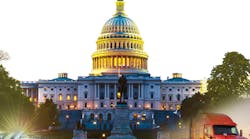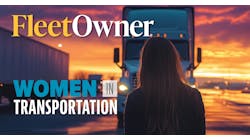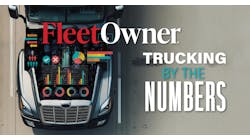One of the most significant trucking regulatory imprints of the Trump administration was the revamped hours of service (HOS) rules that redefined short hauls, break requirements, sleeper berth provisions, and broadened the adverse driving conditions exceptions. Like Donald Trump, who came to Washington, D.C. with his party in control of Congress, Joe Biden and the Democrats have slim majorities in Congress that could push through a cascade of regulations that affect the trucking, transportation, and freight industries.
With those small Democratic majorities in the House and Senate, the party’s fragile grip on D.C. might not last for long. It’s been nearly 20 years since a president’s party retained control of Congress after his first midterm election. In the 117th U.S. Congress, the House’s Democratic caucus has a 10-member advantage (with three vacancies as of March 1); the Senate chamber’s two caucuses are evenly divided with Vice President Kamala Harris breaking the 50-50 tie for the Democrats.
“When you have a slim margin in the Senate, like the Democrats [do], they're going to feel some urgency to try to act before the next round of elections gets here,” Jonathan Starks, chief intelligence officer at FTR Transportation Intelligence, said. “So, we will probably know within the first half of 2021 what that regulatory agenda or legislative agenda really is going to look like and the pace that they’re looking to move.”
If there is one overarching theme for the new administration in Washington, it’s climate change. In one of the many executive orders President Biden signed during his first weeks in office, he made clear that his administration plans to take a government-wide approach to the climate crisis. In one of the major reversals of Trump policy, just hours after being sworn in as the 46th president, Biden announced the U.S. would rejoin the 2015 Paris Climate Agreement.
The new president wants to reshape the U.S. to achieve the Paris Agreement’s net-zero emissions goal by 2050. Biden claims this can be done by building a modern infrastructure system relying on clean energy. To work toward that goal, Biden wants a “whole of government” approach to address climate change.
Environmental impacts in regulations are nothing new for the trucking industry or the U.S. Department of Transportation (DOT). But the past four years of the White House minimizing environmental impacts when writing regulations is over. The new transportation secretary, Pete Buttigieg, made that clear during his U.S. Senate confirmation hearing one day after Biden was sworn in.
“We need to build our economy back better than ever, and the Department of Transportation can play a central role in this by implementing President Biden’s infrastructure vision; by creating millions of good-paying jobs; revitalizing communities that have been left behind, enabling American small businesses, workers, families, and farmers to compete and win in the global economy; and tackling the climate crisis,” Buttigieg told the Senate Committee on Commerce, Science & Transportation. “Infrastructure can be the cornerstone to all of this.”
Buttigieg — who takes office with a national following he garnered during his 2020 presidential campaign — would likely be the face of a Democrat-led infrastructure bill, which is expected to be a top focus in the spring (after Congress comes to terms with Biden’s COVID-19 relief bill).
Infrastructure
The new administration doesn’t have to develop an infrastructure plan from scratch. Last summer, the House Committee on Transportation and Infrastructure (T&I) created a $494 billion funding package that included highway investments and new commercial vehicle regulations.
“The highway bill that came out of T&I last year certainly was a blueprint — or crystal ball, if you will — of what we can expect this year,” David Heller, vice president of government affairs at the Truckload Carrier Association (TCA), told FleetOwner. “It did have some good points, and it had some bad points.”
Any future infrastructure bill would likely include regulatory directives for the DOT and another impactful spending for the trucking industry.
Among the positive points in the 2020 bill that Heller cited was $250 million in grants to build and improve truck parking. He noted that while the pandemic has reduced traffic on highways, which has allowed drivers more flexibility, that won’t last much longer.
“Once we get out of this coronavirus and go back to business as usual, traffic is going to pick back up,” he said. “Drivers are going to need more places to park to avoid congestion and rush hour times.”
Heller also cited safety technologies in the bill that shouldn’t be much of a regulatory shock for fleets. “The majority of our members of TCA are already using speed limiters,” he said. “Speed is the No. 1 cause of accidents out there on the roads today. It’s finally time we take it upon ourselves to actually control those speeds out there and get those accidents under control.”
A concerning part of last year’s legislation includes an increase in the minimum insurance requirements for commercial vehicles: from the current $750,000 to $2 million. It would also require the Federal Motor Carrier Safety Administration (FMCSA) to raise the insurance requirements every five years based on inflation.
According to the Owner-Operator Independent Drivers Association (OOIDA), just 0.06% of crashes lead to damages exceeding $750,000. The amendment in 2020’s bill that included the insurance increases led to OOIDA withdrawing its support for the package.
David J. Osiecki, president of Scopelitis Transportation & Consulting, told FleetOwner “the only real question” is not if this provision would be included in the Democrats’ next infrastructure bill, “it’s really what the numbers will be [and] what the minimum liability insurance requirements will be for general freight truckers, for hazmat truckers, and for other operators.”
Heller said he wouldn’t be surprised if the new Congress pushes for an even higher number than $2 million. “When it comes to minimum insurance, it has to be accompanied by some things such as tort reform,” Heller said. “Quite frankly, these are conversations we’re looking forward to having. We need to highlight the vastness that is the trucking industry.”
That vastness includes giant carriers with thousands of vehicles down to small fleets and owner-operators. “The basic thing is hauling freight from point A to point B and doing so safely,” Heller said.
Vastness also plays a role in the perception of infrastructure, noted Clay Slaughter, FTR’s chief strategy officer and general counsel. “When we say the word infrastructure, you probably have something that comes to mind — you have a project or set of projects; your neighbor has a very different list of projects. And that is the same for the legislature,” he said. “What they see as a project perhaps is a road or bridge or some type of very traditional infrastructure in terms of transportation. Other folks are going to see infrastructure, and they're going to see things like broadband internet access. They're going to see a much different version of what the infrastructure is. And those have very different outcomes for the goods transport sector.”
For Heller, improving infrastructure starts with fixing roads and bridges. The U.S. interstate highway system was once “a shining example” for transportation systems across the world, he said. “And it’s just not that way anymore,” Heller pointed out. “We need to get back to that point.”
One thing that COVID has highlighted, Heller argued, is that freight moves faster when there is less traffic on the roads. He noted that many carriers didn’t need to use HOS exemptions offered during the pandemic “because, frankly, nobody was on the road.” He emphasized the importance of investing in infrastructure to alleviate congestion and deliver freight more efficiently.
Safety
If a provision such as truck speed limiters doesn’t end up in an infrastructure bill, Osiecki said it could be an early regulation of the new DOT. He noted that the Trump administration never took the concept off its regulatory agenda, it just kept this issue on the back burner for the past four years.
One Obama-era proposed rule that the Trump FMCSA withdrew was a requirement for sleep apnea screening of drivers. At the time of the 2016 proposal, the American Transportation Research Institute found that nearly 30% of commercial truck drivers suffered from mild to severe sleep apnea, which is linked to fatigue-related vehicle crashes.
In the old proposal, drivers with a body mass index (BMI) of 40 or higher would be flagged for screening and others with a BMI of 33 or higher could be subject to screening if they meet other criteria.
Osiecki anticipates this rule returning as a top priority for the new FMCSA. “Treating sleep apnea is a good thing because daytime sleepiness is real,” he said. “Fatigue in operations is real. And even if it doesn't cause a catastrophic accident, it can cause near misses and sideswipes and other things like that. So, I think it is truly a safety benefit.”
Other safety regulations ripe for Biden years include making automatic emergency braking (AEB) a mandated rule for truck manufacturers, Osiecki said. While the Obama administration negotiated with major carmakers to ensure they added the AEB technology to all new cars by 2022, he doesn’t anticipate the same approach with truck OEMs.
Strengthening of rear trailer underride guards is another safety regulation ripe for support in the coming years. Of the current guards, Osiecki said there is “concern that the rule is just not stringent enough, that the guard isn’t strong enough, that it’s not protective enough.”
Safety advocacy groups, Osiecki said, want the guards to be stronger, wider, and able to stop more cars that collide with trailers from continuing beneath the trailers. He said the new FMCSA might also consider requiring the guards on the sides of trailers.
Technology
Road technology advancements are also changing how safety can be worked into future infrastructure plans, according to David Braunstein, president of Together for Safer Roads. Statistics involving road crashes and fatalities are a lagging indicator of highway safety.
“What we see happening now is a rapid acceleration of the technologies required to understand the positive and the negative impacts of better road design,” Braunstein told FleetOwner. “That comes down to having better metrics.”
He said that investments in new safety measurement systems — such as in-cab cameras, computer vision, and artificial intelligence — can help the industry understand leading indicators of crashes.
“We can now quantify at scale near misses,” Braunstein said. “Near misses — whether between two personal vehicles or between a personal vehicle and freight operator — affect everybody. And near misses are something that we haven’t been able to get to, technology and mathematically, until recently.”
When Braunstein looks at the potential of spending trillions of dollars on upgrading America’s crumbling infrastructure, he sees an opportunity for more progressive implementations of safety technology. “We see a huge opportunity to scale the kinds of technologies that give us better insight into where the next crash will happen,” he said. “That will make every road user safer and every road user more efficient.”
That efficiency comes with better routing thanks to advanced telematics, better fuel efficiency thanks to more advanced equipment, and better coaching of drivers thanks to more advanced analytics and in-cab technologies.
“You have two things happening at the same time that are coming together to dramatically complement each other: Investments in infrastructure can be complemented by investments in connected vehicles,” Braunstein said.
Labor
The U.S. Department of Labor (DOL) finalized on Jan. 6 a rule that clarifies the standards for an employee versus an independent contractor. It is among the last-minute Trump administration rules that the Biden White House is putting on hold. The DOL rule reaffirmed an “economic reality” test to determine if an individual is in business for him or herself or is economically dependent on a potential employer for work.
The American Trucking Associations favored the rule because of the policy benefits it provides to motor carriers and owner-operators. But union groups such as the Teamsters said it would make it easier for companies to classify their workers as independent contractors, creating a loophole for carriers to get around labor laws.
“We have to protect that business model,” Heller said. “It’s a tried-and-true business model in our industry and has been around for years. Carriers are using it obviously to the benefit of those independent contractors that choose to go down that road and develop small business for themselves.”
Heller sees these topics and the eventual debates over them in the coming months as an opportunity for the trucking industry to show its vast reach “and how some of these rules and regulations may affect trucking.”
Climate
Looking at the new administration’s “whole-government” approach to the environment, attorney Prasad Sharma, a partner at Scopelitis, Garvin, Light, Hanson & Feary, anticipates initial DOT efforts on climate change to be aimed at clean power and emissions from cars and light trucks.
“The EPA is likely to accelerate the clean truck initiative to reduce NOx emissions from heavy-duty trucks,” he said. “You can also expect the Biden administration to push to keep California's ability to regulate under the Clean Air Act — something that the Trump administration pushed back on and tried to eliminate.”
Before taking office, part of Biden’s climate plan included a push for “low-carbon trucking, shipping and aviation technologies,” according to the agenda unveiled by the Biden-Harris Transition Team. The list consists of investing $400 billion over 10 years in clean energy research and innovation. This money would go toward federal research programs to develop more efficient heavy-duty truck engines that would eventually tie into the Paris Climate Agreement’s goal of reaching net-zero emissions by 2050.
Midnight regs in limbo
As has become a tradition when a new administration takes over the White House, Biden issued an order to put a 60-day moratorium on any unpublished regulations in the works to give new administrators time to review them.
“For the FMCSA and DOT purposes, there's not a whole lot of pending regulations in the network,” according to Tim Wiseman of Scopelitis. “A lot of that has to do with 2020 being a unique year. I think FMCSA, in particular, was primarily focused on issuing emergency relief to deal with COVID — making sure the supply chain logistics was not impacted. So, we didn't see a whole lot of new regulations proposed by FMCSA in 2020 that's going to be impacted by the moratorium.”
Among the “midnight regulations” — initiatives pushed through at the end of a president’s term — that are left in limbo by a Jan. 20 memo issued by Biden’s chief of staff are changes to Compliance, Safety, Accountability scores; the under-21 interstate truck driver pilot program proposed in September; the 14-hour HOS pause pilot program proposed in September; along with other CDL, HOS and Drug & Alcohol Clearinghouse exemption requests.




